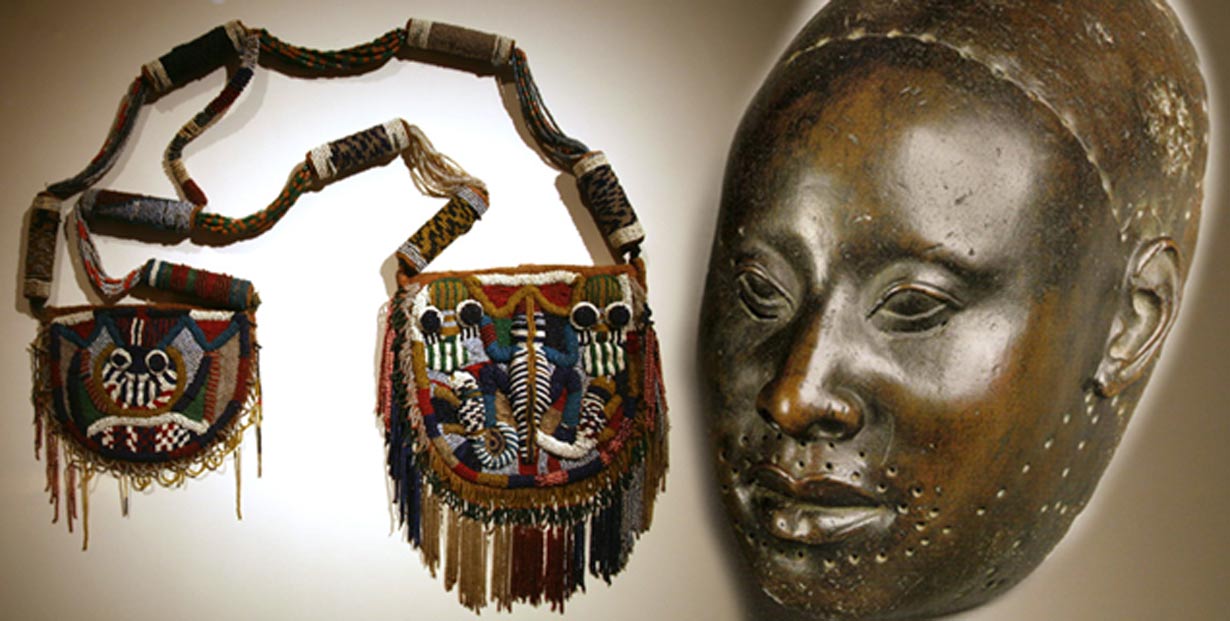
Creation Stories of Africa: The Children of Kings
Africa is a vast continent full of contrasts, and as one would expect, has many and varied stories of creation. Most countries in Africa are made up of different tribes of people, rather than one specific race, so it makes more sense to look at regional stories as opposed to mythologies based on individual nations.
The Children of Oduduwa, West Africa
The Yoruba people from West Africa call themselves the Children of Oduduwa. Oduduwa is held to be the first of all the kings, who came from the east and ruled over ancient Ife, where, with Obatala, he began the creation of the world. Obatala created the first humans out of clay, while Oduduwa became the first divine king of the Yoruba. He sent his sons and daughters out with crowns to rule over all of the other Yoruba kingdoms and all the Yoruba royal families claim descent through them back to Oduduwa.
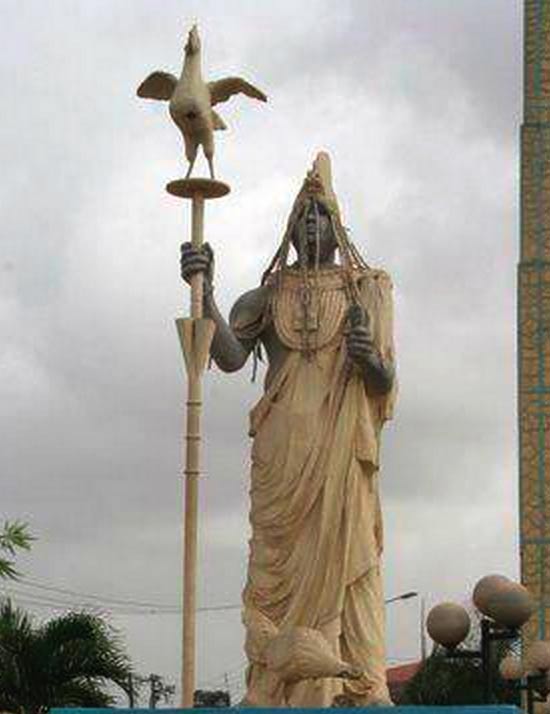
Statue of Oduduwa at Ile-Ife. (CC BY-SA 4.0)
Oduduwa first-born of my sons, to you I give
The five-clawed Bird, the sand of power. Go now,
Call a despairing land to smiling life
Above the jealous sea, and found sure homesteads
For a new race whose destiny is not
The eternal life of Gods. You are their judge;
Yours is the kingship
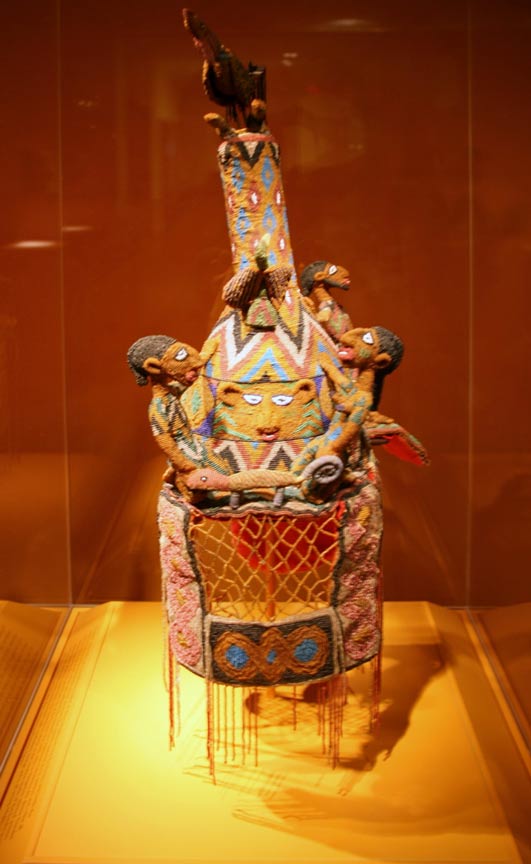
Crown, Yoruba peoples, Ekiti region, Ikere, Nigeria. “A beaded crown with veil is the defining symbol of divine kingship among the Yoruba and holds the combined powers of the living king and the ancestors. The crown's material, form, pattern and color all proclaim the king's sacred power and authority. The frontal face represents Oduduwa, the divine founder and first king of Ile-Ife, the sacred first city of the Yoruba.” (Flicker/CC BY 2.0)
According to the creation story, in the beginning there was only the sky above, water and marshland below. The supreme deity Oludumare gave Obatala the tasks of creating land out of the water and populating it with living creatures. To do this Obatala needed to gather together in a bag: a gold chain long enough to reach down from the sky, a calabash (bottle gourd) filled with soil, a white chicken, a palm nut, and a black cat. With the bag strapped over his shoulder, Obatala hung the gold chain from the corner of the sky and began his descent, however, before he reached the water below, he ran out of chain.
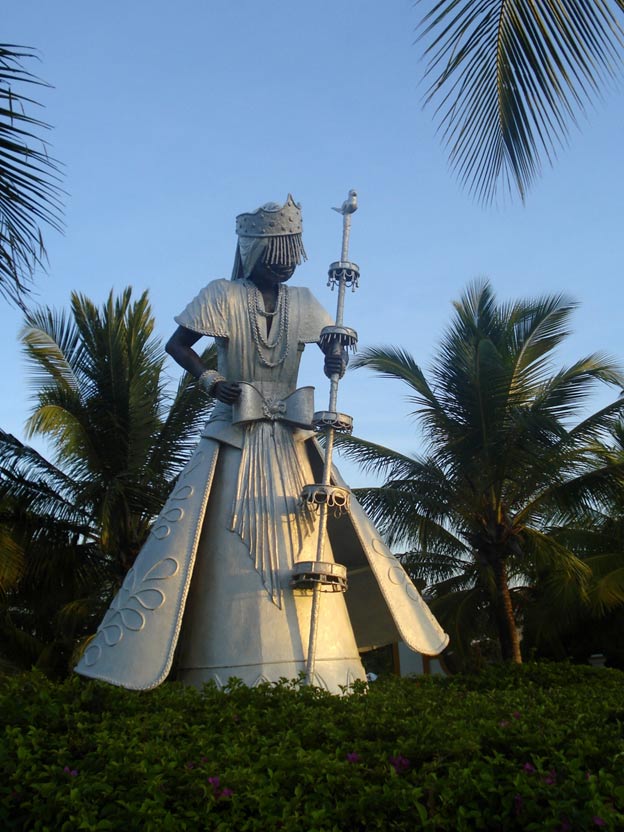
Statue of Obatala. (CC BY 3.0)
Orunmila, the God of Wisdom and Prophecy called down to Obatala telling him to empty the soil from the calabash and at the same time drop the chicken. As the bird landed on the soil it began scratching and scattering the earth all around. As the scattered earth landed it formed a mound. In order not to let the soil dissolve and disappear into the water, Obatala poked his index finger into the mound, allowing the water to flow from beneath the pile and gush out from the top in a fountain that rushed down the side in a great waterfall. He called that place Ife.
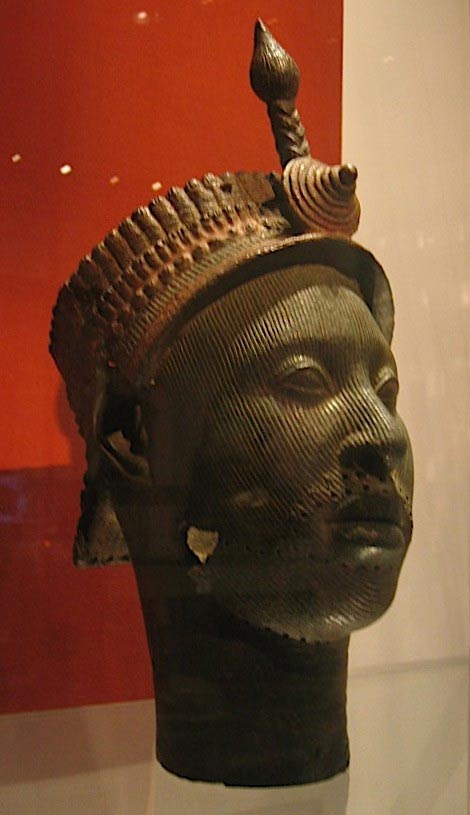
Ife kings head in British Museum. (English Wikipedia user Ukabia /CC BY-SA 3.0)
He planted the palm nut and it immediately grew, so Obatala gathered the new palm nuts and planted them and they grew immediately too. Obatala settled down to a simple life of palm nuts with only the cat for company but, understandably, he grew bored and decided to create beings like himself.
Boshongo of Congo, and The Giant
The Boshongo people are a branch of the Keba, or Kuba, who live in the Kasai region in the south east of the Democratic Republic of Congo. Their story begins, like so many others, in the darkness. The world was completely covered by water and empty, apart from the Creator-God Bumba, a white skinned giant who looked like a man.
One day Bumba got stomach-ache and began vomiting. He vomited up the sun, which gave light to the world, and dried up some of the water, bringing about the clouds. This evaporation process brought land into view and the shape of the countries of the world so was revealed. There were still no living things.
Bumba next vomited up the moon and the stars and so the night-time had its light. Still feeling sick, he vomited up nine creatures: the leopard which was called Koy Bumba, and then Pongo Bumba, the crested eagle. Next came the crocodile, Ganda Bumba, and one little fish named Yo. Bumba then brought up old Kono Bumba, the tortoise, and Tsetse, the lightning. After that came Nyanyi Bumba, the white heron, and a beetle and a goat named Budi. Finally came mankind.
There were many men created, but only one was white like Bumba. His name was Loko Yima. The nine beings went on to create all the creatures that we know today: the goat was responsible for all the animals with horns, the heron created all the birds except the kite. The crocodile made the serpents and the iguana, and subsequently the serpents made grasshoppers, while the iguana made all the animals that didn’t have horns.
Bumba had produced three sons, Nyonye Ngana, Chonganda and Chedi Bumba who were given the task of finishing up the creation. Nyonye Ngana made the ants, but the effort killed him and the grateful ants have been burying him ever since. The second son created a magical plant, which was the forerunner of all the plants and grasses and trees. The third son, Chedi Bumba tried really hard but all he could create was the Kite.
All was well, apart from Tsetse, the lightning, who caused so much trouble that Bumba chased her into the sky where she stayed, occasionally reaching down to the Earth to inflict more damage. Bumba taught the people how to make fire and how to cook. Once all was finished, Bumba told the new people that everything belonged to them.
Fan Tribe and the Trinity of Nzame
The Fan tribe come from the Gabon and Cameroon. They believe that in the beginning there was nothing but Nzame. Nzame is a trinity comprising three personifications: Nzame, Mebere, and Nkwa. It was Nzame who created the universe and the Earth, and set elephants, leopards and monkeys to govern the new place.
Then Nzame decided to create something better, and so the three gods fashioned a new creature in their own image. This was Fam, whose name means power, and he ruled the Earth. After a while Fam grew disrespectful, he mistreated the animals and stopped worshipping Nzame. This upset Nzame, who called up the thunder and the lightning and destroyed the whole world, apart from Fam who was immortal.
The trinity started again by covering the world in a fresh layer of earth, from which a single tree grew. From this tree came many seeds which grew into more trees. As these trees dropped their leaves, those that fell into the water, became fish, and those that fell on the ground turned into animals. Nzame then created a new man, Sekume, who had a soul and a finite term. From another tree, Sekume created a woman and her name was Mbongwe. They had many children.
Dogon Cosmogony and the Visitors from the Sky
There are no written texts of the Dogon cosmogony, instead they are passed on as an oral tradition from generation to generation. It’s said the supreme celestial deity and creator of the universe Amma created an egg—it was the “aduno tal”, the egg of the world and contained the creation model the “Nommo.”
The egg consisted of air, fire and water and a metal called “sagala”, a mysterious heavy metal. In the egg were formed two pairs of twins, one male and one female. One male twin, Yuruga, did not wait for the birth time that Amma had intended, and fell down through space with a fragment of his placenta, which became the earth. The male twin then mated with the earth, in effect its own mother, and so brought imbalance to the newly created world. Realizing his mistake Yuruga tried to climb back up to Heaven to find the female part of the placenta, but Amma had destroyed the other twin to restore the balance.
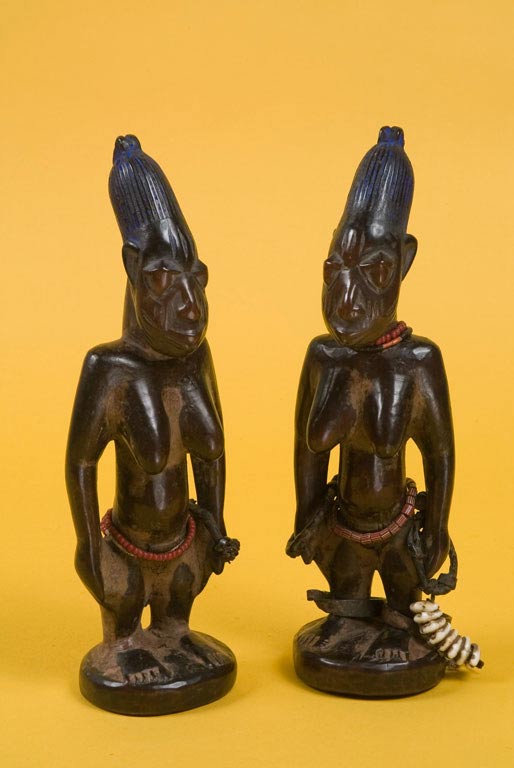
A pair of female Ere Ibeji twin figures. (CC BY-SA 3.0)
Amma then sent the other pair of twins, the other half of the Nommo, to Earth. They came down in an ark that was suspended from Heaven by a chain. At the center of the bridge stood the two Nommo of the Sky. At the four cardinal points were four more pairs of Nommo.
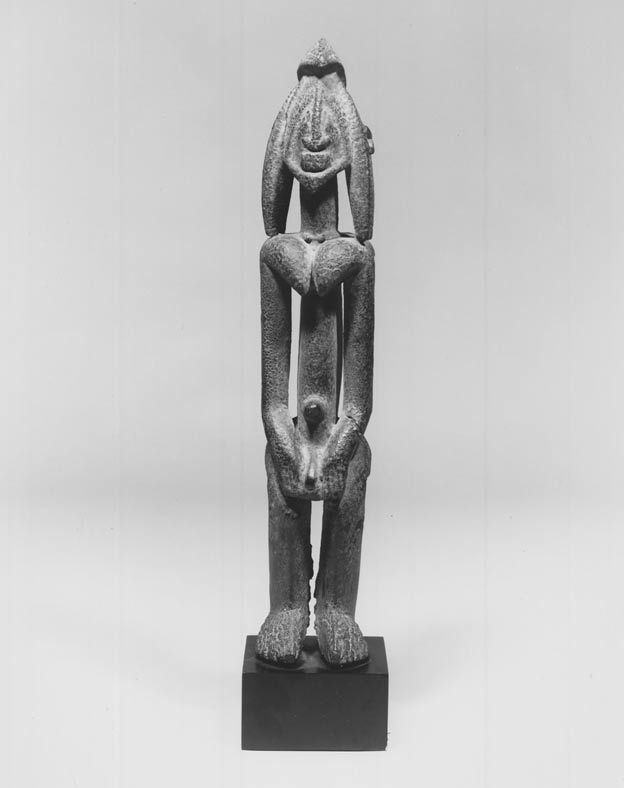
“Figures like this one were placed on ancestral altars as links to a deceased person's soul. It is likely that this figure represents a Nommo, one of the first created beings, who, according to Dogon mythology, had a combination of male and female traits.” (Brooklyn Museum / CC BY 3.0)
The Nommo are said to come down from the skies in a craft accompanied by flames and thunder. When they landed they immediately created a reservoir and dove into the water. They are described as being more fishlike than human and so are obliged to live in water. The Nommo are also referred to as Masters of the Water, The Monitors, and The Teachers. Rain fell on the new earth and fertilized the eight seeds that the Nommo had brought with them. From these eight seeds came forth humans, animals and plants. Amma created the stars by throwing pellets of earth into space. He created the sun and moon by modelling two white earthenware bowls, one encircled with red copper, the other with white copper. Black people were believed born under the sun and white people under the moon.
Credo Mutwa is a South African Zulu Sangoma and High Sanusi. Born in Zululand in 1921, Credo was raised a Christian but after a long illness was told by his grandfather that he must become a Shaman. His immediate family’s reaction was one of horror and he was forced to leave home and take to the open road. His travels brought him in contact with many wise men and women who were happy to impart their wisdom to the young sangoma. His mission has become one of preservation as he believes that the culture of his people is being eroded away by western influence.
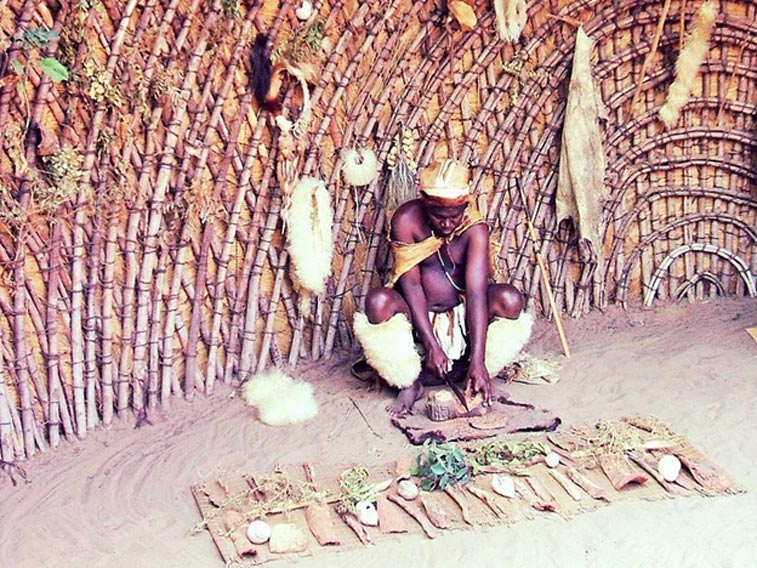
The cuisine of the traditional village Shaman, Swaziland. (PIERRE ANDRE LECLERCQ /CC BY-SA 4.0)
Credo Mutwa has become a world renowned expert on the occult history of Africa, an acclaimed author, artist, sculptor and poet.
No stars were there – no sun,
Neither moon nor earth –
Nothing existed but darkness itself –
A darkness everywhere.
Nothing existed but nothingness
A Nothingness neither hot nor cold,
Dead nor alive –
A Nothingness far worse than nothing
And frightening in its utter nothingness.
Ancestral Spirits of the Zulu
Among the Zulu, there is a strong belief in the ancestral spirits (amadlozi or abaphansi). These are the spirits of the dead. The Zulus believe in a supreme deity. UMvelinqangi was the first to appear; indeed, his name means One Who Came First. This supreme god has never been seen by anyone and so is not worshipped directly. It is said that the spirits of the dead are the communication channel between UMvelinqangi and the Zulu people. He is a Sky-God who speaks through the thunder and hurls lightning bolts when he is angry. He married Uhlanga, a female deity who came from the marshes. From this union sprang the primeval reeds and from them came UNkulunkulu, the Very Big One.
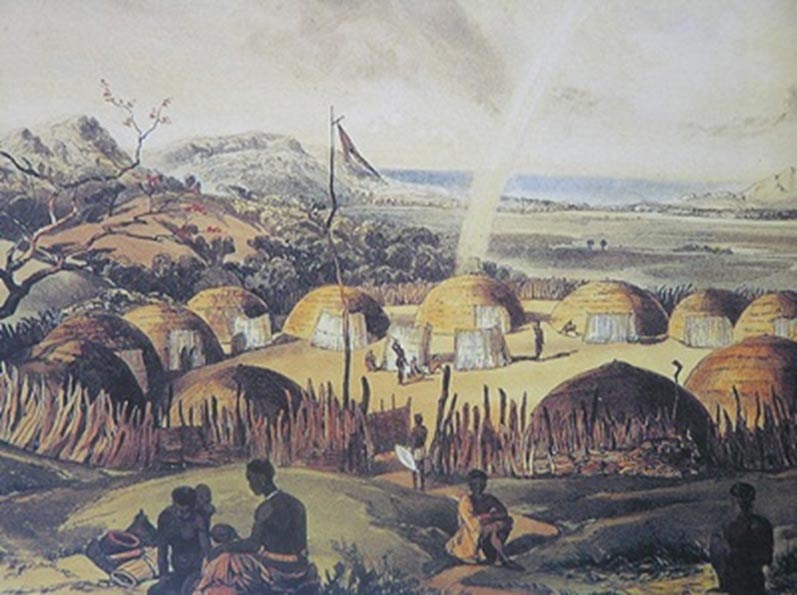
A Zulu Kraal enclosure, 1849 (Public Domain)
From UNkulunkulu’s seed came forth the people and the animals. Through his breath and through his word were created elephants, the stars, the moon, mountains, streams, and snakes. He taught the Zulu how to hunt, how to make fire, and how to grow food. He is considered to be the First Man and is in everything that he created.
Some storytellers say that people emerged from a stone which UMvelinqangi split in two, while others say people came up from a lower world. According to Zulu healer Laduma Madela, UMvelinqangi appeared in a vision while he was meditating in a sacred grove where the creation tree grew. The creation tree formed an arc that Madela saw as the roof of the Heavens. In the vision, UMvelinqangi showed Madela how he created the world. UMvelinqangi ordered an elephant to break open a door in a great hollow copper stone in the lowest world. He emerged from this door followed by all living creatures, including the first people.
Another Zulu creation epic tells the tale of Ninavanhu-Ma, the Creator Mother Goddess who was ordered by UNkulunkulu to bring about creation. She began her task by bringing forth the sun and the stars, then she fashioned the Earth. Pausing for a rest she was overcome with loneliness and began to cry. She cried so loudly that the stars trembled and fell from the sky. She wept so many tears that she formed a massive lake that swept over the Earth, shaping the rivers and streams that flow to this day until finally, UNkulunkulu grew so fed up with her noise that he told her to stop at once and make good the land and the stars that she had damaged with her crying.
But the Mother Goddess was lonely and wanted a companion, so UNkulunkulu gave her what she wanted. He created the Tree of Life, but to the beautiful Goddess he appeared ugly with dozens of bloodshot eyes and a mouth with a thousand pointed fangs. Ninavanhu-Ma ran like the wind, but the Tree scooped a huge ball of rock and clay and threw it far up into the sky. The ball, bigger than Kilimanjaro, flew after the fleeing Goddess, hit her squarely on the back of the head, bounced off, and settled into orbit as the moon. It is still revered to this day for its power over lovers.
Having captured his wife, the Tree of Life held her tightly until one day the Goddess felt a great pain inside her. Thinking his wriggling, reluctant bride was trying to escape again, the Tree held her even more tightly. Finally, after a further fifty years, she began to give birth to the first people. Meanwhile the Tree of Life began to bud and shed seeds. The falling seeds germinated in the barren ground, grass grew for the first time and trees began to sprout. Then the Tree of Life bore fruit. This was animal fruit, which dropped to the ground and ran off into the freshly growing bush. Great cracks appeared in the Tree’s trunk and from them flew out all the birds of the Earth, from its roots came the lizards, the snakes and all the other reptiles. The first people are known as the Red People.
The Maasai, and Catastrophe of the Sky and Earth
To Kenya, East Africa and the Maasai, the supreme Creator deity is Enkai, also written Ngai. Enkai has two aspects, Enkai Narok, the Black God, who is good and benevolent, and Enkai Nanyokie, the Red God, who is full of rage and vengeance.
In the beginning Enkai, whose name also means Sky, owned all the cattle in the world, until a huge catastrophe separated the Sky and the Earth. Enkai sent the cattle down via a long rope made of bark, for the Maasai to look after, but a passing group of hunters, jealous of the Maasai, cut the rope, severing all connections between Heaven and Earth. The Maasai believe that Enkai intended all the cattle in the world for them, to the extent that they will still take, by force if necessary, cattle from neighboring tribes.
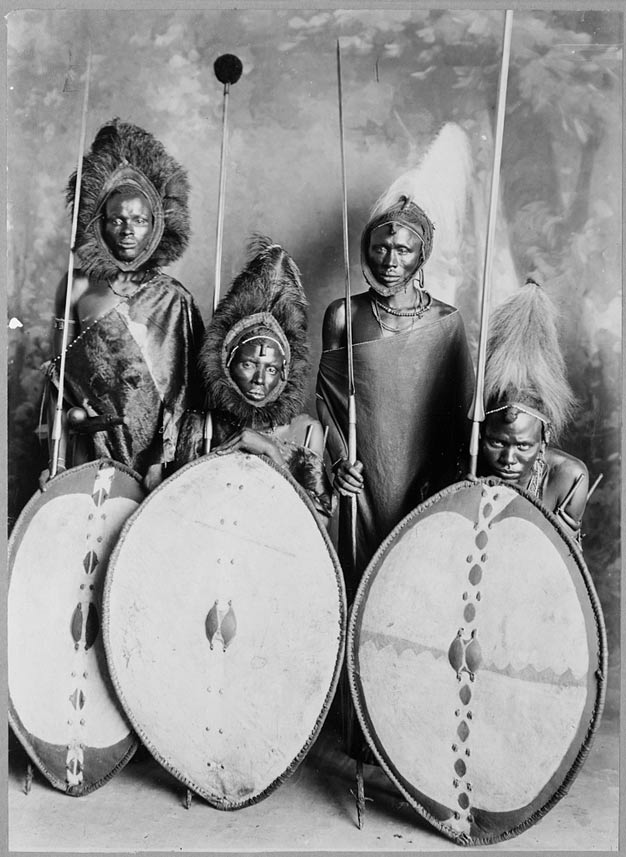
Four Maasai warriors in full war dress, Kenya. (Public Domain)
They believe that Enkai created three groups of people to roam the earth. The first is the Torrobo people, the hunters and gathers, to whom Enkai sent honey and wild animals. The second group is the Kikuyu, the farmers who got grain and seed. The final group is the Maasai.
Enkai, although he lived in the Heavens, would often come to Earth and rest on Mount Kenya, from where he could inspect his creation. The Kikuyu claim that Enkai, Ngai (or Mulungu as he is also known) took the first man, Gikuyu, to the top of Mount Kenya and showed him the lush lands below, telling him to go to a distant grove of wild figs where he would find a wife waiting for him. She was named Mumbi and she bore nine daughters but no sons, so Gikuya and Mumbi called to Enkai for help and he sent nine handsome men and so the tribe of the Kikuyu was born.
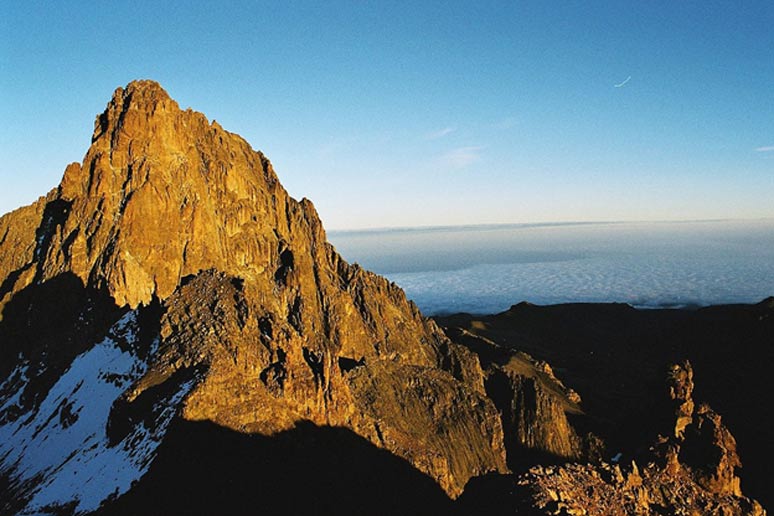
The second highest mountain in Africa, Mount Kenya. (Hdahlmo~commonswiki /CC BY 2.5)
What is interesting to note about African mythologies, and we have touched on just a handful here, is how, perhaps unlike many other ancient myths and legends, they are still very much a part of daily life for a great many people living on this multicultural continent.
Featured image: Deriv; Yoruba Copper mask for King Obalufon, Ife, Nigeria c. 1300 C.E. (Public Domain), Diviner's bag, Yoruba peoples, Oyo region, Nigeria. (CC BY 2.0)
References
Wyndham J., Myths of Ife, London, 1921
Credo Mutwa, Indaba my Children, New York, 1964